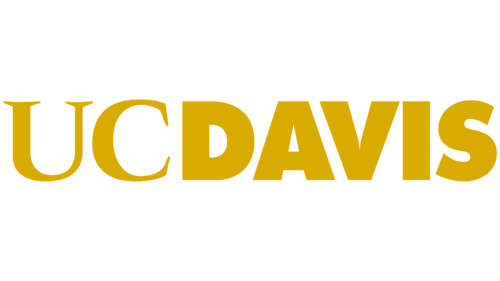The UC Davis logo reflects the university’s core values: the pursuit of the light of knowledge. Its slogan, “Let there be light,” which means “Let there be light,” confirms this fact.
UC Davis: Brand overview
| Founded: | 1905 |
| Headquarters: | Yolo County and Solano County, California, United States |
| Website: | ucdavis.edu |
The time when the institution of higher learning came into being was 1905. At first, it was an agricultural department of the University of Berkeley, and only then, in 1959, it received the status of a university. Now the University of California, Davis, is a major center, the seventh in the California system of higher education. It is known for its management, law, veterinary medicine, and medicine departments. According to U.S. News & World Report, UCD ranks 14th on the list of public universities in the United States. It also conducts research in all core disciplines and has an R1 level. Its athletic teams are members of NCAA Division I.
The Davis-based institution was based on another institution of higher learning, the University of California of Berkeley. Beginning in 1868, it immediately opened its own College of Agriculture. But in time, it needed a university farm where students could hold practical classes and conduct experiments. A law for such structures was passed in 1905. The local government allocated land in Yolo County for this purpose and built several buildings.
In 1909 based on this department was officially established University Farm School with a 3-year professional training program. But it did not grant any degrees, so students enrolled in it for a short period to complete an internship and then leave again to study in Berkeley. This was inconvenient, and interested parties began agitating for the separation of the college at Davis from the parent institution. Eventually, in 1922, the Board of Trustees was forced to introduce a four-year program with a bachelor’s degree.
This approach gave a powerful boost to UCD’s development. Unexpectedly, educational institutions became very much in demand. In 1938 it was renamed the College of Agriculture at Davis. By 1951 the area of the institution had grown to 1,200 acres. In 1958, the agricultural program was phased out, and then UC Davis, a full-fledged campus of the University of California, opened. Over time, it developed various majors: engineering, medicine, veterinary medicine, and others. It also developed its athletic department, the Aggies, whose members compete in the Big West Conference in NCAA Division I.
Meaning and history
The visual identity of UC Davis demonstrates an attitude toward learning. The university puts it above the other tasks usually assigned to American universities because it even has a doctoral program. If you focus only on identity, you can trace its movement from traditionalism to modernism. That is why the letters in the logo look like large geometric shapes, while the seal, on the contrary, contains a set of classic elements. Among them are a book, a star, rays, and a ribbon.
The unifying factor of the UC Davis seal and logo is color. The university’s sign is golden yellow, too. Otherwise, they are completely different. In particular, the logo presents the university’s name in an abbreviated version. The abbreviation “UC” is typed in thin glyphs with sides of different widths. It is written in antiqua. The word “Davis,” on the other hand, consists of very bold letters with massive feet. It makes use of the grotesque. The background of the text is a neutral white color. There are no geometric frames. The characters stand close to each other, and to prevent the words from merging, the designers combined the different thicknesses of the glyphs.
What is UC Davis?
UC Davis is an acronym for the University of California from Davis. It originated in 1905 and was first the agriculture department of a Berkeley institution of higher learning. It gained higher education status in 1959. UCD offers education in several fields, including medicine, law, management, veterinary medicine, and several others. It is awarded a high level of education and research – R1. It also has its athletic department, which includes 25 teams called Aggies.
The UC Davis seal reflects the paramount importance of education to the institution’s administration. It underscores: an institution of higher learning brings enlightenment and lights the light of reason. And UCD is also a guiding star leading to a bright future. All these ideas are expressed through the simple image of a five-pointed star at the top. Thanks to the one-sided shadows that the designers added, it has sharp edges. There are also thin straight stripes pointing in different directions.
In their background, in the center, there is an open book entwined with a ribbon, where the university’s slogan is written in English. It seems to connect all the details into a whole and promotes the concept that learning is light. The design is made with narrow lines of golden color. A wide blue stripe with the full name of the institution of higher learning surrounds the middle. A bold dot separates each word. The letters are colored yellow. The font in the inscription is uppercase, with miniature sharp serifs. The seal is taken in a ring of many small circles and separated from the center by a small white space.
Font and Colors
Although Proxima Nova, Freight Text, and Ryman Eco are considered university fonts, the lettering in the logo is in other typefaces. These include analogs of Limerick Serial Heavy or SoftMaker’s Ornitons Serial Heavy, as well as a variation similar to Garamond Serial Xbold.
Color is the main unifying factor in UC Davis’ visual identity. The official palette includes Aggie Blue and Aggie Gold. The signature gold is present in the print, the logo, and the athletic department symbolism. Both colors are rich, dark, and noble.
UC Davis color codes
| Fluorescent Orange | Hex color: | #ffbf00 |
|---|---|---|
| RGB: | 255 191 0 | |
| CMYK: | 0 25 100 0 | |
| Pantone: | PMS 7549 C |
| Cool Black | Hex color: | #022851 |
|---|---|---|
| RGB: | 2 40 81 | |
| CMYK: | 98 51 0 68 | |
| Pantone: | PMS 655 C |






